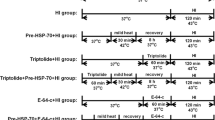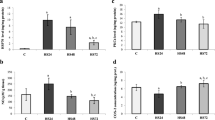Abstract
Intense heat stress induces damage to the heart, whereas mild to moderate heat stress protects the heart against subsequent ischemic injury. The mechanisms underlying the detrimental and beneficial effects of heat stress remain unclear. In this study, we investigated the role of p53 in the responses of cardiac muscle cells to acute heat exposure and heat acclimation (HA). Heat exposure increased the levels of caspase and annexin, and levels of cytosolic, nuclear, and mitochondrial p53 protein in H9c2 cells. Pifithrin-α or pifithrin-μ reduced heat-induced apoptotic response in these cells. HA reduced localization of p53 in the mitochondria and improved cell viability during heat exposure. The effects of heat exposure and HA on p53 were further verified in vivo in mouse heart tissue. These results suggest that p53 plays a role in heat-induced apoptosis in cardiac muscle cells. The protective effect of HA against heat injury likely involves a p53-dependent mechanism.








Similar content being viewed by others
References
Crandall, C. G., & Wilson, T. E. (2015). Human cardiovascular responses to passive heat stress. Comprehensive Physiology, 5(1), 17–43.
Qian, L., et al. (2004). Mitochondrial mechanism of heat stress-induced injury in rat cardiomyocyte. Cell Stress & Chaperones, 9(3), 281–293.
Yu, T., Deuster, P., & Chen, Y. (2016). Role of dynamin-related protein 1-mediated mitochondrial fission in resistance of mouse C2C12 myoblasts to heat injury. The Journal of Physiology, 594(24), 7419–7433.
Matsumoto, H., et al. (1994). p53 proteins accumulated by heat stress associate with heat shock proteins HSP72/HSC73 in human glioblastoma cell lines. Cancer Letters, 87(1), 39–46.
Brady, C. A., & Attardi, L. D. (2010). p53 at a glance. Journal of Cell Science, 123(Pt 15), 2527–2532.
Racay, P., et al. (2007). Effect of ischemic preconditioning on mitochondrial dysfunction and mitochondrial p53 translocation after transient global cerebral ischemia in rats. Neurochemical Research, 32(11), 1823–1832.
Guo, X., Sesaki, H., & Qi, X. (2014). Drp1 stabilizes p53 on the mitochondria to trigger necrosis under oxidative stress conditions in vitro and in vivo. The Biochemical Journal, 461(1), 137–146.
Trangmar, S. J., et al. (2017). Whole body hyperthermia, but not skin hyperthermia, accelerates brain and locomotor limb circulatory strain and impairs exercise capacity in humans. Physiological Reports, 5(2), e13108.
Horowitz, M. (2016). Epigenetics and cytoprotection with heat acclimation. Journal of Applied Physiology, 120(6), 702–710.
Ong, S. G., et al. (2014). HIF-1 reduces ischaemia-reperfusion injury in the heart by targeting the mitochondrial permeability transition pore. Cardiovascular Research, 104(1), 24–36.
Maloyan, A., et al. (2005). HIF-1alpha-targeted pathways are activated by heat acclimation and contribute to acclimation-ischemic cross-tolerance in the heart. Physiological Genomics, 23(1), 79–88.
Gross, E. R., & Gross, G. J. (2007). Ischemic preconditioning and myocardial infarction: an update and perspective. Drug Discovery Today: Disease Mechanisms, 4(3), 165–174.
Islam, A., et al. (2013). An exploration of heat tolerance in mice utilizing mRNA and microRNA expression analysis. PLoS One, 8(8), e72258.
Chen, Y., & Yu, T. (2017). Glucocorticoid receptor activation is associated with increased resistance to heat-induced hyperthermia and injury. Acta Physiologica (Oxford, England), 222(4), e13015.
Komarov, P. G., et al. (1999). A chemical inhibitor of p53 that protects mice from the side effects of cancer therapy. Science, 285(5434), 1733–1737.
Strom, E., et al. (2006). Small-molecule inhibitor of p53 binding to mitochondria protects mice from gamma radiation. Nature Chemical Biology, 2(9), 474–479.
Kuennen, M., et al. (2011). Thermotolerance and heat acclimation may share a common mechanism in humans. American Journal of Physiology. Regulatory, Integrative and Comparative Physiology, 301(2), R524–R533.
Zhao, Y., et al. (2005). p53 translocation to mitochondria precedes its nuclear translocation and targets mitochondrial oxidative defense protein-manganese superoxide dismutase. Cancer Research, 65(9), 3745–3750.
Kanno, S., et al. (2015). Pifithrin-alpha has a p53-independent cytoprotective effect on docosahexaenoic acid-induced cytotoxicity in human hepatocellular carcinoma HepG2 cells. Toxicology Letters, 232(2), 393–402.
Dai, C., & Gu, W. (2010). p53 post-translational modification: deregulated in tumorigenesis. Trends in Molecular Medicine, 16(11), 528–536.
Chipuk, J. E., et al. (2005). PUMA couples the nuclear and cytoplasmic proapoptotic function of p53. Science, 309(5741), 1732–1735.
Nieminen, A. I., et al. (2013). Myc-induced AMPK-phospho p53 pathway activates Bak to sensitize mitochondrial apoptosis. Proceedings of the National Academy of Sciences of the United States of America, 110(20), E1839–E1848.
Endo, H., et al. (2006). Mitochondrial translocation of p53 mediates release of cytochrome c and hippocampal CA1 neuronal death after transient global cerebral ischemia in rats. The Journal of Neuroscience, 26(30), 7974–7983.
Miller, M. W., & Ziskin, M. C. (1989). Biological consequences of hyperthermia. Ultrasound in Medicine & Biology, 15(8), 707–722.
Clowes Jr., G. H., & O'Donnell Jr., T. F. (1974). Heat stroke. The New England Journal of Medicine, 291(11), 564–567.
Chang, C. K., et al. (2007). Oxidative stress and ischemic injuries in heat stroke. Progress in Brain Research, 162(1), 525–546.
Moseley, P. L. (1997). Heat shock proteins and heat adaptation of the whole organism. J.Appl.Physiol, 83(5), 1413–1417.
Qi, Z., et al. (2011). Physical exercise regulates p53 activity targeting SCO2 and increases mitochondrial COX biogenesis in cardiac muscle with age. PLoS One, 6(7), e21140.
Borras, C., Gomez-Cabrera, M. C., & Vina, J. (2011). The dual role of p53: DNA protection and antioxidant. Free Radical Research, 45(6), 643–652.
Redza-Dutordoir, M., & Averill-Bates, D. A. (2016). Activation of apoptosis signalling pathways by reactive oxygen species. Biochimica et Biophysica Acta, 1863(12), 2977–2992.
Yu, T., et al. (2018). Mitochondrial fission contributes to heat-induced oxidative stress in skeletal muscle but not hyperthermia in mice. Life Sciences, 200(1), 6–14.
Acknowledgments
We thank Jacob Dohl for the technical assistance.
Funding
This work was supported by Congressionally Directed Medical Research Program Award W81XWH-14-2-0133.
Author information
Authors and Affiliations
Corresponding author
Ethics declarations
Conflict of Interest
The authors declare that they have no conflicts of interest.
Ethical Approval
All applicable international, national, and/or institutional guidelines for the care and use of animals were followed.
Disclaimer Statement
The opinions and assertions expressed herein are those of the author(s) and do not necessarily reflect the official policy or position of the Uniformed Services University or the Department of Defense.
The contents of this publication are the sole responsibility of the author(s) and do not necessarily reflect the views, opinions, or policies of The Henry M. Jackson Foundation for the Advancement of Military Medicine, Inc. Mention of trade names, commercial products, or organizations does not imply endorsement by the US Government.
Additional information
Associate Editor Nicola Smart oversaw the review of this article
Publisher’s Note
Springer Nature remains neutral with regard to jurisdictional claims in published maps and institutional affiliations.
Rights and permissions
About this article
Cite this article
Chen, Y., Yu, T. Involvement of p53 in the Responses of Cardiac Muscle Cells to Heat Shock Exposure and Heat Acclimation. J. of Cardiovasc. Trans. Res. 13, 928–937 (2020). https://doi.org/10.1007/s12265-020-10003-w
Received:
Accepted:
Published:
Issue Date:
DOI: https://doi.org/10.1007/s12265-020-10003-w




